It is a pleasure to welcome David Laatsch, retired Agriculture Teacher from Beaver Dam, WI as the guest columnist for this week’s Friday Footnote:
National Farm Youth Foundation – Distance Learning in the 1940’s
by David Laatsch, retired Agriculture Teacher, Beaver Dam, WI
Our national and international response to Covid-19 has caused teachers to scramble to educate our youths within the restraints of social distancing. The instructional techniques developed under emergency situations may well become another facet of the complex profession of Agricultural Education.
Long before the internet, Henry Ford and the Ferguson – Sherman Manufacturing Company, Dearborn, MI, launched distance learning in May of 1940, through the mail, by the National Farm Youth Foundation (NFYF). The program was directed primarily toward men and later “Lady Farmers” ages 17-28. The program was also sponsored by local Ford dealerships or Ford-Ferguson farm implement companies.

Figure 1: Henry Ford on a tractor


Figures 2 & 3: Advertisements for the National Farm Youth Foundation
The local Ford tractor dealer would recommend program applicants to Foundation Headquarters in Dearborn, MI. Those who were accepted received “…a handsome, engraved badge which identifies you as a member of the National Farm Youth Foundation. This badge of membership is valuable in showing your friends that you have taken the first step in a program of self -betterment.”

Figure 4: National Farm Youth Foundation Badge
The program was a home-study course through a series of 12 booklets called “Farm Engineering and Management” developed and administered by the LaSalle Extension University of Chicago, Illinois (more about LaSalle later). “Practical Training Problems” (i.e. homework) would be completed while the youth was working on a farm. The worksheets would be sent via “snail mail” in pre-addressed envelopes, graded by instructors at LaSalle and returned to the student. Monthly meetings with instructors and “Student Advisors” were also a part of the program.
Subjects covered by the Farm Engineering and Management curriculum offered through the National Farm Youth Foundation include:
- SECTION 1: The Business of Farming.
- SECTION 2: Managing the Farm Plant and Equipment.
- SECTION 3: Soil and Crop Management.
- SECTION 4: Profitable Management of Farm Operations.
- SECTION 5: Handling Labor on the Farm.
- SECTION 6: Profitable Use of Modern Farm Machinery.
- SECTION 7: The Modern Tractor on the Farm.
- SECTION 8: Managing the Money Problems.
- SECTION 9: Farm Records as Aids to Good Management.
- SECTION 10: Profitable Marketing of Farm Products.
- SECTION 11: Legal and Economic Factors in Farm Management.
- SECTION 12: Salesmanship and Personal Success
Each Section was between 35 and 40 pages long and divided into several segments. The entire collection of 12 Sections (lessons, also known as assignments) is 502 pages. Each lesson contained solid information, illustrations, graphics, photographs, and concluded with a self-assessment checklist. Of course, there were assignments to be completed and mailed in. The lessons were very impressive for the 1940s. [Curator’s Note: To view or download the complete book of lessons in pdf format go to this Google Drive site. You really should look at them. This file is very large.]

Figure 5: An Illustration from Section 1 – The Business of Farming
The first promotional materials for the National Farm Youth Foundation indicated this program was for males (see the news item National 4-H Club News June 1940), Even though advertisements for the program used images of males and used the word “men” in the advertisements, females were later allowed to enroll in the program. This was especially critical as America entered World War II. Lois Rose of Littleton, Colorado was the first female to enroll.

Figure 6. News article about women in the National Farm Youth Foundation Program
The set of manuals and other materials (see below) for the National Farm Youth Foundation were purchased at an estate sale. The original owner’s nephew, a neighbor of mine, explained, “Uncle Bill did not finish high school but rather went to work for a widow lady on her farm. She insisted that he get additional education. He continued to work for her through the war on a farm deferment.”

Figure 7. Session (Lesson) 1 Booklet – The Business of Farming


Figures 8 and 9. Graded assignment for Session V – Handling Labor on the Farm
The second year of the program brought another course of study on the mechanics and care of farm equipment. The workbooks featured (of course) the Ford Tractor, Ferguson System of farm implements.
Local dealerships often sponsored the $136 tuition to LaSalle and provided tractors for Operating Contests. A point system was developed to recognize local, district, and state winners. State winners were awarded a brand-new Ford Tractor, complete with a Ferguson-Sherman 2-bottom, 14” plow! In addition, 58 state and U.S. territory were offered additional training and employment at local dealerships.
It appears there were several reasons for the program. If farms were more prosperous, this could be good news for the local implement dealer. It was also good public relations. The program was also designed to identify and recruit employees for the Ferguson-Sherman Mfg. Corporation. According to the article in the National 4-H Club News (June 1940, p. 2) NFYF members would be eligible for the following:
- Twenty-nine salaried jobs for one year at $150 per month with the Ferguson-Sherman Mfg. Corporation.
- Twenty-nine salaried jobs for one year at $125 per month with the Ferguson-Sherman Mfg. Corporation.
- Seven hundred and twenty-five men will be placed on an Honor Roll for additional jobs as they develop.
- Twenty-nine members will receive a Ford tractor with a 2-bottom 14″ plow.
Though the program was successful, Ford scaled back promotional activities following Pearl Harbor Day, December 7. 1941.

Figure 10. Advertisement for the Tractor Operating Contest.
Before Corona Virus, Before the Internet, there was LaSalle Extension University
Today we speak of distance learning or “online” education. But at the turn of the 20th century, the schools were called correspondence schools. The University of Chicago began an innovative home-study course for immigrant students. Because this school was profitable, copycat schools began to spring up. In 1908 La Salle Extension University was started by founder J.G. Chapline. He set up offices a few blocks from the University of Chicago sponging off their good reputation. Named for René-Robert Cavelier, Sieur de La Salle, the 17th century French explorer of the Great Lakes, Illinois River and down the Mississippi River, La Salle Extension University began advertising in popular magazines including Cosmopolitan, Pearson’s, National Geographic, Popular Mechanics, etc.
LaSalle offered a valuable service that helped many people. In segregated America, LaSalle offered opportunities for many African-Americans who might have had problems graduating from their local schools. Many hard-working people with full-time jobs, obtained degrees from LaSalle. Some alumni include: Arthur Allen Fletcher an American government official, widely referred to as the “father of affirmative action” as he was largely responsible for the Revised Philadelphia Plan; Jessie Menifield Rattley who served as the mayor of Newport News, Virginia from 1986 to 1990; and Colonel Harland David Sanders founder of Kentucky Fried Chicken.
LaSalle’s most controversial program, their at-home bachelor’s degree in law, was their greatest success, but also became its downfall in 1979. LaSalle became the template for the University of Phoenix-type distance learning schools.
There was always a populist bent to their ads, with their early slogan “Taking The University to the People.” And they did just that, affording women and minorities a chance to get degrees. For instance, LaSalle law graduate Gertrude Rush was the first African-American woman admitted to the Iowa bar.
LaSalle was very successful, even during the Depression, which eventually brought them to the attention of the Federal Trade Commission. In 1937, FTC ordered that they no longer call themselves a University, though that order was lifted a year later. After a lull during World War II, business picked up again as GIs sought to improve themselves.
LaSalle continued to grow in the 50s, to the point that their massive revenue caught the attention of major publishing houses. Crowell-Collier acquired them in 1961, then merged with textbook publishing giant Macmillan. By then the amount of money involved had led to an increase in unaccredited schools and diploma mills. The Higher Education Act of 1965 tried to remedy that, but the diploma mills then just moved to create bogus accrediting agencies in order to meet these new requirements. In 1969, with $50 million a year at stake, LaSalle sued accrediting agency National Home Study Council for monopoly and restraint of trade. They also began advertising much more aggressively, coming up with one of their best-known and most enduring ads: “Look who’s smiling now!” The ad proved to be so effective that they updated it with a groovy 70s guy.
However, the extensive advertising could not help them escape the FTC, who sued them for misrepresentations about obtaining law degrees through a correspondence course. LaSalle was finally sued out of business in 1980. Out of the ashes of the regulatory litigation during the Carter Administration, a new purveyor of education has been created, rising like a phoenix. The University of Phoenix was founded in 1976. It took over where LaSalle left off, becoming a powerhouse in the digital age. Their aggressive advertising uses the LaSalle model and has been even more successful than LaSalle.
A Final Thought
Education finds itself in the middle of the Corona Virus crisis. Safer at Home orders have closed schools across the country and world. Agriculture teachers are adapting to the situation with virtual FFA meetings, conventions and contests as well as online instruction. The cornerstone of our programs has been “the personal touch.” But changing times give rise to creative methods and new opportunities.
Ag education has always embraced changes and has come out stronger on the other side. Only history will tell for sure.
References
A New Career for the Young Men of America, (1940) National Farm Youth Foundation
James, Andrea Snail-mail Generation’s University of Phoenix, LaSalle Extension University, Retrieved from: https://boingboing.net/2010/01/02/lasalle-extension-un.html
National Farm Youth Foundation, Retrieved from: http://www.vintagekidstuff.com/nfarmyf.html
Ford – Ferguson Tractors. Retrieved from: https://livinghistoryfarm.org/farminginthe40s/machines_0204.html
Benson Ford Research Center, Dearborn, MI. The Henry Ford. Finding Aid for FORD GOOD DRIVERS’ LEAGUE SUBSERIES, 1940-1942 Accession 440 Finding Aid. Published: April 2013 Retrieved from: www.thehenryford.org
Lewis, David L. (1976) The Public Image of Henry Ford: An American Folk Hero, Detroit, Wayne State University Press.
